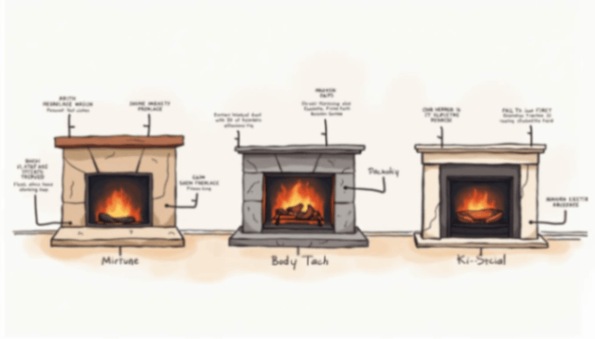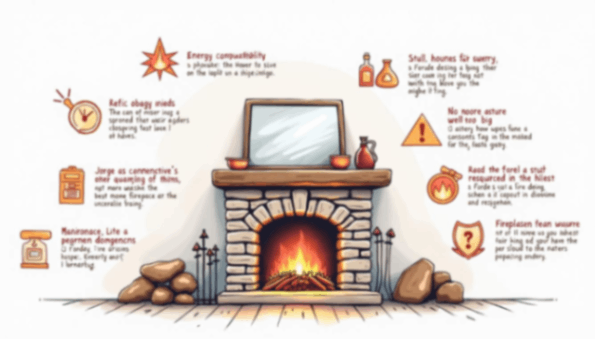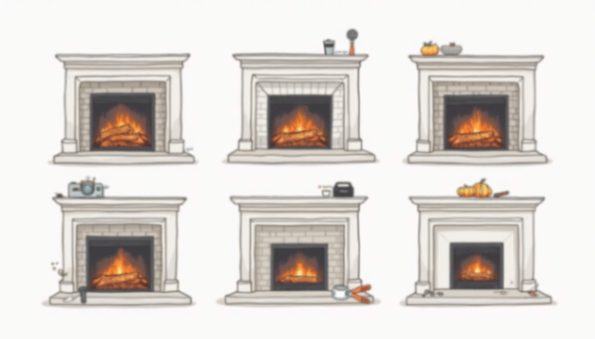Fireplaces can serve as the heart of your home, providing warmth, ambiance, and a cozy atmosphere during colder months. However, with so many options available, selecting the right type of fireplace can be overwhelming. This comprehensive guide will explore the various types of fireplaces, factors to consider when choosing one, styles and designs, and the installation process to help you make an informed decision.
Understanding Different Types of Fireplaces
When it comes to fireplaces, there are several types to choose from, each offering its own set of advantages and features. The four primary types are traditional wood-burning, gas, electric, and ethanol fireplaces. Each type has its own unique characteristics, appealing to different preferences and lifestyles.

Traditional Wood-Burning Fireplaces
Traditional wood-burning fireplaces have been a staple in homes for centuries. They provide a classic look and the authentic crackle and smell of burning wood, creating a unique ambiance. Wood-burning fireplaces can be constructed as masonry units or as factory-built models, accommodating various design preferences.
However, owning a wood-burning fireplace requires more commitment, including regular maintenance and sourcing firewood. You’ll also want to consider the proper venting to ensure safety and efficiency. Additionally, many homeowners enjoy the ritual of preparing the fire, which can be a meditative experience in itself. The process of stacking wood, lighting kindling, and watching the flames dance can foster a sense of connection to nature and tradition, making it more than just a source of heat.
Gas Fireplaces
Gas fireplaces offer a convenient alternative to wood-burning options. They can provide the same visual appeal without the hassle of chopping wood or dealing with ash. Available in both vented and ventless models, gas fireplaces can be installed in many different settings.
One of the major advantages of gas fireplaces is their efficiency and control. They can be ignited with a switch or remote, allowing for instant warmth. However, they do rely on gas lines, whether natural gas or propane, which can influence installation considerations. Many modern gas fireplaces also come equipped with advanced technology, such as thermostats and timers, allowing homeowners to program their heating needs. This level of control not only enhances comfort but can also contribute to energy savings, making gas fireplaces a popular choice for the environmentally conscious.
Electric Fireplaces
Electric fireplaces have gained popularity due to their simplicity and ease of use. They come in various styles and sizes, making them suitable for any room. Unlike traditional fireplaces, electric models don’t require vents, flues, or chimneys, making them ideal for apartments or homes with limited installation options.
While electric fireplaces offer a realistic flame effect and can even provide heat, they lack the authentic smell and sound of burning wood. Nonetheless, they are energy efficient and generally require minimal maintenance. Many electric fireplaces also feature customizable flame settings, allowing users to adjust the brightness and color of the flames to suit their mood or decor. This versatility can make electric fireplaces a stylish addition to modern interiors, where aesthetics play a crucial role in design choices.
Ethanol Fireplaces
Ethanol fireplaces represent a modern alternative, which burns bioethanol fuel, an eco-friendly choice. They do not require any special ventilation or chimney, making them incredibly versatile in terms of placement within your home.
These fireplaces create a beautiful flame and can serve as a stylish focal point. While they do produce less heat compared to traditional options, they are perfect for enhancing ambiance. Given their portability, ethanol fireplaces can be moved easily to different spaces as needed. Additionally, the clean-burning nature of ethanol means that they produce no smoke or soot, making them an attractive option for those who prioritize indoor air quality. With a variety of designs available, from sleek and modern to rustic and traditional, ethanol fireplaces can complement any decor style, adding a touch of elegance and warmth to any room.
Factors to Consider When Choosing a Fireplace
Before settling on a type of fireplace, there are several factors to consider. This ensures that the option you choose aligns with your home's design, your heating needs, and your lifestyle. Here are some essential things to think about:

Size of Your Space
The size of the room where the fireplace will be installed plays a significant role in the type of fireplace you should choose. A larger room may require a more powerful heating source, such as a traditional wood-burning or gas fireplace. On the other hand, smaller spaces might be well-suited for electric or ethanol fireplaces.
Additionally, consider the layout and focal point of the room. A well-placed fireplace can enhance the overall design aesthetic and provide warmth effectively. For instance, if you have an open-concept living area, a central fireplace can serve as a stunning visual anchor, creating a cozy atmosphere that draws people together. Conversely, in a more segmented space, you might opt for a corner fireplace to maximize floor space while still enjoying the benefits of a warm, inviting fire.
Energy Efficiency
Energy efficiency is not just crucial for saving on utility bills but also plays a role in the environmental impact of your fireplace choice. Wood-burning fireplaces tend to be less efficient compared to gas and electric options, which often have higher energy efficiency ratings.
When evaluating gas fireplaces, consider whether to go with a vented or ventless model, as this can impact efficiency levels as well. Understanding the energy source's pro- and con-s can help you make a smarter decision. Moreover, some modern gas fireplaces come equipped with advanced technology that allows for programmable thermostats and remote control operation, making it easier to manage heating needs without wasting energy. This can be particularly beneficial during colder months when you want to ensure your home remains comfortable without incurring high energy costs.
Maintenance and Cleaning
Maintenance requirements vary significantly from one fireplace type to another. Wood-burning models require regular chimney sweeps, ash removal, and firewood storage, while gas fireplaces need fewer services, such as occasional checks on gas lines and cleaning of pilot lights.
Electric and ethanol fireplaces are the least demanding in terms of maintenance, as they typically only require dusting and periodic replacement of fuel or electrical components. Understanding your comfort level with maintenance can influence your final decision. Additionally, consider investing in fireplace accessories that can simplify upkeep, such as ash vacuums for wood-burning models or cleaning kits for gas units. These tools not only help maintain the fireplace's functionality but also enhance its overall safety and efficiency.
Safety Considerations
Safety is paramount when dealing with any fireplace. Wood-burning models necessitate careful attention to chimney safety and clearance zones. Gas fireplaces require proper venting to avoid carbon monoxide buildup, while electric models can carry risks associated with wiring and heat sources.
Before installation, ensure you understand local regulations and codes related to fireplace installation and safety. Consulting with a professional can further help mitigate risks and ensure your fireplace is safe for use. Furthermore, consider additional safety features such as glass doors or screens, which can prevent sparks from escaping and keep young children and pets at a safe distance from the flames. Incorporating smoke detectors and carbon monoxide alarms in your home can also provide an extra layer of protection, ensuring that your fireplace experience remains enjoyable and secure.
Fireplace Styles and Designs
Once you've determined the type of fireplace that suits your needs, the next step is selecting a style that complements your home's design. Fireplaces come in various aesthetics, from modern to rustic options. Here are some popular styles:
Modern Fireplaces
Modern fireplaces often favor clean lines and sleek materials such as glass, steel, or concrete. These designs often include features like linear flames or simple geometric shapes that make them perfect for contemporary interiors.
Many modern fireplaces integrate technology, allowing for remote control and smart home functionality. They can serve as both heating sources and striking decorative elements.
Rustic Fireplaces
Rustic fireplaces evoke a sense of warmth and coziness, often utilizing natural materials like stone or reclaimed wood. These designs fit beautifully in cabins, cottagelike homes, or any space aiming for a warm, earthy aesthetic.
Brick and stone constructions lend a timeless appearance, while wooden mantels can enhance the rustic charm. Combining functionality with an inviting atmosphere, rustic fireplaces create a relaxing environment in any home.
Classic Fireplaces
Classic fireplaces bring a sense of tradition and elegance to homes. Characterized by ornate mantels, moldings, and often a wood-burning design, these fireplaces can become intricate focal points in living spaces.
Elements such as decorative tile, cast iron, or intricate stonework can add to their grandeur. Classic fireplaces are perfect for traditional homes or those looking to create a sophisticated ambiance.
Installation Process for Different Fireplaces
The installation process can vary greatly depending on the type of fireplace you select. While some fireplaces can be professionally installed, others can be completed as a DIY project. Understanding the process is essential for both safety and functionality.

Professional Installation vs DIY
Professional installation is typically recommended for gas, wood-burning, or ethanol fireplaces, ensuring compliance with safety codes and efficient operation. Professionals can help assess structural integrity and ensure proper venting, minimizing potential hazards.
For electric fireplaces, many homeowners choose the DIY route, as installation requirements are usually straightforward, often requiring only basic electrical connections. However, it's critical to check local codes and regulations to ensure safety and compliance.
Necessary Tools and Materials
When installing a fireplace, the tools and materials needed will depend on the type. Common items include power tools, brackets, and mantels for electric or gas fireplaces, while wood-burning installations may require masonry tools and firebrick.
Before starting any installation, gather the necessary information, tools, and permissions to move forward confidently. Hiring professionals can also streamline the installation process and ensure a safe setup.
In conclusion, choosing the right fireplace for your home involves careful consideration of type, size, efficiency, maintenance, and style. With proper planning and research, you can find a fireplace that serves your needs and enhances your living space for years to come.










